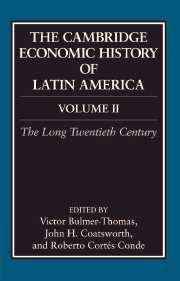Book contents
- Frontmatter
- Introduction
- Part I Cycles of Globalization
- 1 Globalization in Latin America before 1940
- 2 Foreign Capital Flows
- 3 The External Context
- 4 Globalization and the New Economic Model in Latin America
- Part II Onset of Modernization
- Part III Factor Endowments
- Part IV Sectoral Development and Equity
- Bibliographical Essays
- Index
- References
4 - Globalization and the New Economic Model in Latin America
from Part I - Cycles of Globalization
Published online by Cambridge University Press: 28 March 2008
- Frontmatter
- Introduction
- Part I Cycles of Globalization
- 1 Globalization in Latin America before 1940
- 2 Foreign Capital Flows
- 3 The External Context
- 4 Globalization and the New Economic Model in Latin America
- Part II Onset of Modernization
- Part III Factor Endowments
- Part IV Sectoral Development and Equity
- Bibliographical Essays
- Index
- References
Summary
The import-substituting industrialization (ISI) model of development reached maturity in the 1950s. It began to show signs of decadence in the 1960s when timid reforms were attempted in several countries to address its major weaknesses. In the Southern Cone (Argentina, Chile, and Uruguay), economic reforms became more radical in the 1970s, but elsewhere in Latin America the reform movement stalled and the distortions attributable to the ISI model became more apparent. By 1982, when the debt crisis struck Latin America, the ISI model was almost completely discredited and there were few voices left to defend it.
The debt crisis in Latin America at the beginning of the 1980s had many causes. The export sector was too small and insufficiently dynamic to finance the increase in debt service payments; the rise in world interest rates pushed up the cost of servicing the debt; and the growth in world liquidity in the 1970s meant that banks started to look for new business in the larger developing countries. The latter would now come to be known as “emerging” countries to emphasize the shallowness of their financial markets and their potential for absorbing new inflows of capital.
Extricating Latin America from the debt crisis would prove to be a long and costly affair. The term “lost decade” has rightly been used to describe the stagnation in real gross domestic product (GDP) per head that resulted in the 1980s from the adjustment programs adopted throughout the region. These programs were designed to ensure that Latin American countries did not default on their debt and, to that extent, they were largely successful. However, a high price was paid in terms of the reduction in social spending and the deterioration in infrastructure.
- Type
- Chapter
- Information
- The Cambridge Economic History of Latin America , pp. 135 - 166Publisher: Cambridge University PressPrint publication year: 2006



